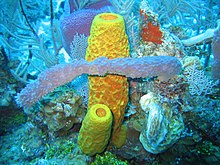Niphates digitalis
| Pink vase sponge | |
|---|---|

| |
| The pink vase sponge (Niphates digitalis) is seen in the back of the photo, behind three other species of sponges. | |
| Scientific classification | |
| Domain: | Eukaryota |
| Kingdom: | Animalia |
| Phylum: | Porifera |
| Class: | Demospongiae |
| Order: | Haplosclerida |
| Family: | Niphatidae |
| Genus: | Niphates |
| Species: | N. digitalis
|
| Binomial name | |
| Niphates digitalis (Lamarck, 1814)
| |
| Synonyms | |
|
List
| |
Niphates digitalis, commonly known as the pink vase sponge, is a species of sea sponge belonging to the family Niphatidae. It is native to the Florida Keys, The Bahamas, and the Caribbean including the Netherlands Antilles.[1] The species was first described by Jean-Baptiste Lamarck in 1814.[2]
Characteristics[edit]
The pink vase sponge is a demosponge that can grow up to 50 cm in height and width, but is more commonly smaller. It is normally vase-, tube-, or cup-shaped with a narrow base and broader top, and somewhat flattened when viewed in cross section. Rarely, it can grow as a fan shape.[3] Despite its name, the colour has been observed as blue, gray, and lavender, as well as "purplish to pink".[1] The surface is coarse and porous with 6-mm-long conules or spines.[3]
Chemistry[edit]
Compounds extracted from the pink vase sponge have been investigated for their possible use in the treatment of castration recurrent prostate cancer.[4] A common reagent used in organic chemistry 1,8-diazabicycloundec-7-ene can be isolated from this sponge.[5]
References[edit]
- ^ a b "Niphates digitalis". Encyclopedia of Life. Retrieved 13 April 2016.
- ^ "Niphates digitalis (Lamarck, 1814)". World Porifera Database. Retrieved 13 April 2016.
- ^ a b "Niphates digitalis (Lamarck, 1814) Haplosclerida, Niphatidae". Portol.org. Retrieved 13 April 2016.
- ^ Meimetis LG, Williams DE, Mawji NR, Banuelos CA, Lal AA, Park JJ, Tien AH, Fernandez JG, de Voogd NJ, Sadar MD, Andersen RJ (2012). "Niphatenones, glycerol ethers from the sponge Niphates digitalis block androgen receptor transcriptional activity in prostate cancer cells: structure elucidation, synthesis, and biological activity". J Med Chem. 55 (1): 503–14. doi:10.1021/jm2014056. PMID 22148427.
- ^ Smitha, Graham & Lynchb, Daneil E. (2016). "Crystal structures of three anhydrous salts of the Lewis base 1,8-di-aza-bicyclo-[5.4.0]undec-7-ene (DBU) with the ring-substituted benzoic acid analogues 4-amino-benzoic acid, 3,5-di-nitro-benzoic acid and 3,5-di-nitro-salicylic acid". Acta Crystallogr E. 72 (3): 382–386. doi:10.1107/S205698901600267X. PMC 4778835. PMID 27006813.
